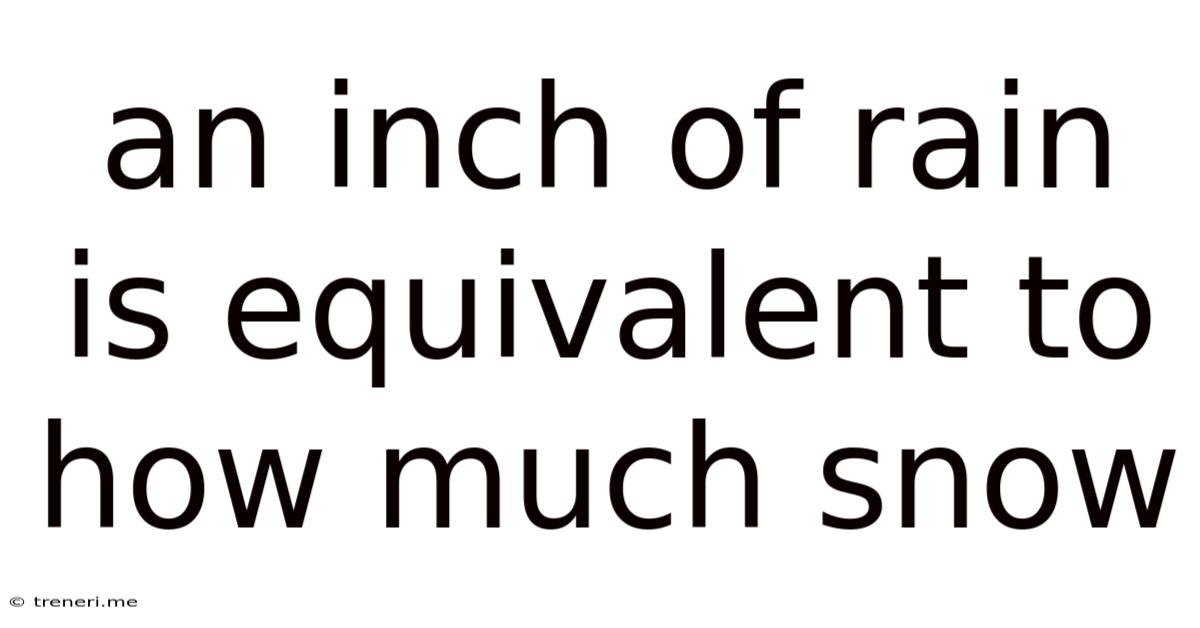An Inch Of Rain Is Equivalent To How Much Snow
Treneri
May 12, 2025 · 4 min read

Table of Contents
An Inch of Rain is Equivalent to How Much Snow? Understanding the Snow-to-Water Ratio
The question, "An inch of rain is equivalent to how much snow?" doesn't have a simple, one-size-fits-all answer. The conversion ratio between snow and rain is highly variable and depends on several crucial factors. While a general rule of thumb exists, understanding the nuances is vital for accurate estimations, particularly in fields like hydrology, meteorology, and even winter sports planning.
Understanding the Snow-to-Water Ratio: The Fundamentals
The core concept revolves around the snow-to-water ratio (SWR), also known as the snow-water equivalent (SWE). This ratio represents the amount of liquid water contained within a given volume of snow. Essentially, it answers the question: how much water would you get if you melted all the snow?
A common, yet crude approximation is that 10 inches of snow is equivalent to 1 inch of rain. This means an SWR of 10:1. However, this is a broad generalization, and the actual ratio can vary wildly from 4:1 to even 50:1 or more!
Factors Affecting the Snow-to-Water Ratio
Several factors significantly influence the SWR, making consistent conversion challenging:
1. Snow Density: The Primary Driver
The density of the snowpack is the most critical factor. Freshly fallen, fluffy snow is very light and contains a lot of air. This results in a high SWR (e.g., 20:1 or even higher). As the snow ages and compacts due to melting, refreezing, and the weight of subsequent snowfall, its density increases. This denser snowpack has a lower SWR (e.g., 5:1 or even less).
Think of it this way: a fluffy snowdrift is mostly air, whereas a packed snowball is almost entirely water ice. The latter holds significantly more water in the same volume.
2. Temperature: Affecting Density and Melt
Temperature fluctuations dramatically impact snow density. Warmer temperatures promote melting, leading to denser snow and a lower SWR. Conversely, consistently cold temperatures maintain fluffy, low-density snow, increasing the SWR. Freezing and thawing cycles further complicate the matter.
3. Wind: Influencing Snowpack Structure
Wind can create drifts, leaving some areas with deep, loose snow (high SWR) and others with packed, dense snow (low SWR). This uneven distribution makes accurate estimations difficult, especially over large areas.
4. Precipitation Type: Wet vs. Dry Snow
The type of snowfall itself affects density. Wet, heavy snow (often associated with warmer temperatures) is denser than dry, powdery snow (common in colder conditions). Wet snow naturally has a lower SWR than dry snow.
5. Snow Crystal Shape and Size: Microscopic Variations
Even the shape and size of individual snow crystals play a role, although this is a less readily quantifiable factor. Complex, dendritic crystals trap more air than simpler, granular crystals, leading to higher SWRs.
The Challenges of Accurate Conversion
The variability inherent in these factors makes establishing a precise, universally applicable conversion exceptionally difficult. While the 10:1 ratio serves as a useful starting point, it's essential to acknowledge its limitations and potential inaccuracies.
For instance, attempting to convert a snowfall measurement from a mountaintop (high SWR due to cold, light snow) to a lowland valley (lower SWR due to warmer, denser snow) using a 10:1 ratio would yield a vastly inaccurate estimate of the water equivalent.
Practical Applications and Considerations
Despite the challenges, understanding the snow-to-water ratio has significant practical implications:
-
Flood Forecasting: Accurate SWR estimations are crucial in predicting potential flooding during snowmelt. Overestimating or underestimating the water volume released from a snowpack can have severe consequences.
-
Water Resource Management: Knowing the water content of the snowpack helps in managing water resources for irrigation, drinking water supply, and hydropower generation. Accurate SWR measurements are essential for long-term water resource planning.
-
Avalanche Risk Assessment: Snowpack density, a key factor influencing SWR, is a vital component in assessing avalanche risk. Changes in SWR can indicate unstable snow conditions.
-
Winter Sports: Understanding snowpack properties is relevant for ski resort operations, trail maintenance, and winter recreation safety.
Beyond the 10:1 Ratio: More Refined Approaches
While the 10:1 ratio serves as a rough guide, more sophisticated methods exist to determine SWR:
-
Snow Surveys: Professionals use specialized equipment to measure snow depth and density at various locations. These data are used to calculate the SWE more accurately. This often involves taking snow samples and measuring their weight and volume.
-
Remote Sensing: Satellites and aerial surveys employing radar and other technologies can provide large-scale estimations of snowpack water content.
-
Weather Models: Advanced weather models incorporate various factors (temperature, precipitation type, wind) to predict snow accumulation and estimate SWE with increasing precision.
Conclusion: A Nuance-Rich Relationship
The relationship between an inch of rain and the equivalent amount of snow isn't straightforward. While the 10:1 ratio offers a convenient initial approximation, it’s vital to recognize the influence of factors like snow density, temperature, and wind. Accurate conversion necessitates a deeper understanding of these influencing factors and potentially the application of more advanced measurement techniques. The next time you hear about snowfall measurements, remember that the actual water content can vary dramatically depending on the specific conditions. This inherent variability underscores the importance of considering the complexities of the snow-to-water ratio in various fields.
Latest Posts
Latest Posts
-
How Many Ml In 14 Ounces
May 12, 2025
-
Calcular Carga Maxima De Una Viga
May 12, 2025
-
How Many Days Is 60 Weeks
May 12, 2025
-
How To Calculate A Fish Tank Volume
May 12, 2025
-
What Is 3 6 Equivalent To
May 12, 2025
Related Post
Thank you for visiting our website which covers about An Inch Of Rain Is Equivalent To How Much Snow . We hope the information provided has been useful to you. Feel free to contact us if you have any questions or need further assistance. See you next time and don't miss to bookmark.